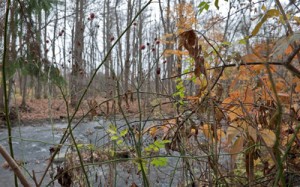A New Walking Path
From Bob Anderson
 Almost a decade ago I was able to buy a humble second home, which sits above a flood-plain forest along the South River in Conway.
Almost a decade ago I was able to buy a humble second home, which sits above a flood-plain forest along the South River in Conway.
Over three years I renovated, working at it when I could find the time. It was rented for a few years, then stood empty for a time. Now that I am semi-retired, many of my days, and most of my evenings and nights, are spent in this space where the sound of the river puts me to sleep, and the greens in the garden grow sweet and strong.
About two years ago, while the property was vacant, Jack Lochhead telephoned me. We had a long conversation concerning issues of conservation, as identified by a community group to which he belongs, called the Friends of the South River. Initially the group was interested in creating a long walking trail along the river, but that idea soon connected to concerns about riverbank erosion, damage by invasive plant species, the health of fish and animal habitat, and the preservation of rich flood-plain farmland. A grant to document the physical and biological attributes of the river had been applied for and I wrote a letter of support for the project. Later I was happy to learn that the grant was awarded. There will be a public meeting to review the information once it has been gathered.
Jack had begun the river trail along his property, near the beginning of Reed’s Bridge Road. I had found his mowed and tended trail while scouting the river for fishing pools. His efforts to expand the trail were blocked by complications, until clearance was granted for a trail around the town-owned seven-acre field that borders the river just below the town center. This would be a small part of the contemplated several miles of river trail, but something was better than nothing.
He mowed a trail around the perimeter, but could not get next to the river because of heavy brush and bushes along most of the bank. This is good for the river: as poor as the fishery has become, it remains important to preserve shaded water for the sake of trout survival during the heat of summer.
Early one late July morning, Jack and I arrived at the town field armed with an ax, an adz, a shovel, and some handsaws. The mission was to create a series of river access points along the part of the walking path that borders the river. We began at the end of the field near town. In that area there are some trees, so it wasn’t very difficult to dig a path down to the river through the mildly thick underbrush.
While I was finishing the last few feet, Jack found a natural clearing downstream and under some low trees, about halfway along the length of the field’s edge. He opened the area by simply cutting a few limbs and bushes. The result is an opening with a view of the water, poetically covered by a canopy of shade-giving leaves. The only negative is a steep three-foot bank that prevents water access, but the view of the stream is very fine.
At the downstream end of the field, away from town, the river makes a right angle turn, runs about two hundred yards toward the west, then makes an opposite right angle turn to resume the flow toward the north. Near the center of this westerly run, which defines the width of the field, Jack began to cut a path to the water.
The vegetation of this area is dominated by a battle between trees and a bamboo-like plant commonly called knotweed. I have heard that it was once imported from Asia to be cultivated in Hadley as pulp for paper. It is now a common sight in Conway near damp areas. The juvenile plants rise a foot or two above the ground to form pretty little mini-forests of dark green stalks, about the diameter of pencils and ringed at intervals like bamboo. The trouble is, when mature, they end up higher than a man and thick as thieves! Across the river from this access-through-the-knotweed, a beautiful flood plain-forest begins. If the trees near the path could win the battle, perhaps a similar but smaller forest could be established here.
Getting rid of knotweed is damned tedious. Jack knew that from efforts on his land. I found out on another work morning when we went after some of the knotweed “forest”- but only after we had obtained permission from the Conservation Commission to work at its eradication. We chopped at it, I dug up some of it, and we laid it along the path to dry in the sun, as it can reroot when wet. There is a lot more to cut in that area; it will return, and is only eradicated after several cuttings.
So, we did a little to improve access to the natural beauty of Conway, and we did a little to restore the native botany. As one of our members said, nature is made more beautiful through the love of it. There is a lot that is ugly in the world. I consider myself lucky to live in a beautiful place, and supporting the preservation of its natural beauty makes my old bones feel better.